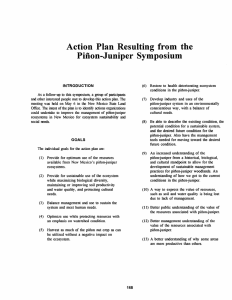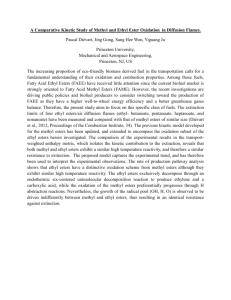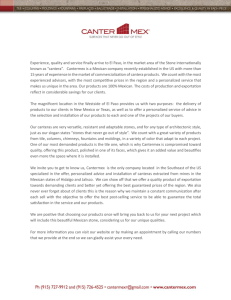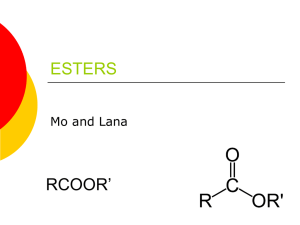Pinus edulis The Composition of Oils in
advertisement
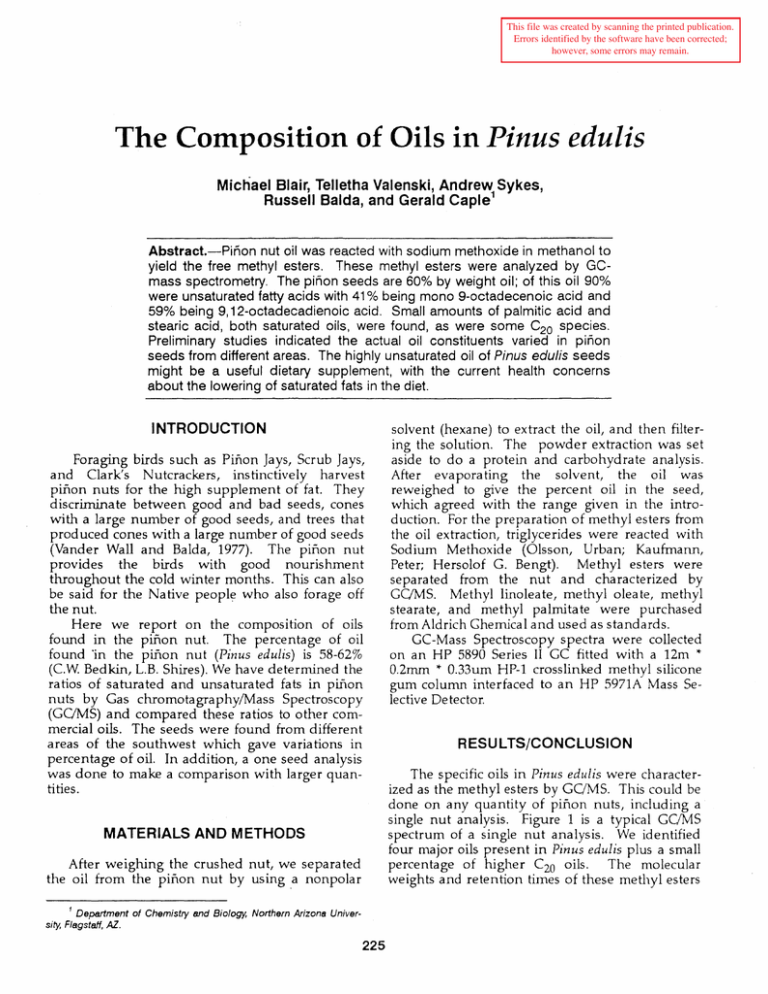
This file was created by scanning the printed publication. Errors identified by the software have been corrected; however, some errors may remain. The Composition of Oils in Pinus edulis Michael Blair, Telletha Valenski, Andrew1 Sykes, Russell Balda, and Gerald Caple Abstract.-Pinon nut oil was reacted with sodium methoxide in methanol to yield the free methyl esters. These methyl esters were analyzed by GCmass spectrometry. The pinon seeds are 60% by weight oil; of this oil 90% were unsaturated fatty acids with 41 % being mono 9-octadecenoic acid and 59% being 9, 12-octadecadienoic acid. Small amounts of palmitic acid and stearic acid, both saturated oils, were found, as were some C20 species. Preliminary studies indicated the actual oil constituents varied in pinon seeds from different areas. The highly unsaturated oil of Pinus edulis seeds might be a useful dietary supplement, with the current health concerns about the lowering of saturated fats in the diet. INTRODUCTION Foraging birds such as Pinon Jays, Scrub Jays, and Clark's Nutcrackers, instinctively harvest pinon nuts for the high supplement of fat. They discriminate between good and bad seeds, cones with a large nwnber of good seeds, and trees that prod uced cones with a large number of good seeds (Vander Wall and Balda, 1977). The pinon nut provides the birds with good nourishment throughout the cold winter months. This can also be said for the Native peopl~ who also forage off the nut. Here we report on the composition of oils found in the pmon nut. The percentage of oil found 'in the pmon nut (Pinus edulis) is 58-62% (C.W Bedkin, L.B. Shires). We have determined the ratios of saturated and unsaturated fats in pmon nuts by Gas chromotagraphylMass Spectroscopy (CC/MS) and compared these ratios to other commercial oils. The seeds were found from different areas of the southwest which gave variations in percentage of oil. In addition, a one seed analysis was done to make a comparison with larger quantities. MATERIALS AND METHODS After weighing the crushed nut, we separated the oil from the pinon nut by using ,a nonpolar 1 Department of Chemistry and Biology, Northern Arizona University, Flagstaff, AZ. 225 solvent (hexane) to extract the oil, and then filtering the solution. The powder extraction was set aside to do a protein and carbohydrate analysis. After evaporating the solvent, the oil was reweighed to give the percent oil in the seed, which agreed with the range given in the introduction. For the preparation of methyl esters from the oil extraction, triglycerides were reacted with Sodium Methoxide (Olsson, Urban; Kaufmann, Peter; Hersolof C. Bengt). Methyl esters were separated from the nut and characterized by GC/MS. Methyl linoleate, methyl oleate, methyl stearate, and methyl palmitate were purchased from Aldrich Chemical and used as standards. GC-Mass Spectroscopy spectra were collected on an HP 5890 Series II GC fitted with a 12m >I0.2mm >I- 0.33um HP-I crosslinked methyl silicone gun1 column interfaced to an HP 5971A Mass Selective Detector. RESULTS/CONCLUSION The specific oils in Pinus edulis were characterized as the methyl esters by CC/MS. This could be done on any quantity of pinon nuts, including a single nut analysis. Figure 1 is a typical CC/MS spectrum of a single nut analysis. We identified four major oils present in Pinus edulis plus a small percentage of higher C 20 oils. The molecular weights and retention tilnes of these methyl esters Composition Table 1.-Retentlon Times ot Methyl Esters (minutes). Palmitate Mol.Wgt. Shelled(Feb) Shelled (June) Freezer Nuts Palmitate 270 Linolenate 292 Linoleate 294 Oleate 296 Stearate 298 270 15.97 17.42 17.1 17.19 L1nolenate L1noleate 294 292 Shoulder Shoulder 18.77 18.55 Oleate Stearate 296 18.31 19.22 18.85 298 18.34 19.38 19.05 of Oil 7 7 i'r 7 /.I! COITONSEED /j! L 1L //A • Saturated /,/1 • Monounsaturated • Dlunsaluraled / f;) O:her OLIVE V V / .. . PEANUT 18.82 'L L / SAFFLOWER 18.92 V 18.96 / / / SESAME 19.04 V / / ,. / SOYBEAN are given in Table 1. The molecular weights and the retention times of methyl esters purchased from Aldrich closely match the methyl esters found in the pinon nut. The shelled nuts (Feb) were run under different GC conditions (higher Heliun1 column pressure) accounting for the faster in retention times. The freezer nut sample obtained from a commercially available source and of unidentified history also contained an additional unsa tura ted oil at 18.55 min (asterisk-Figure 2). 2GDOOOO 241)000:: 2000COJ 161J')coa / V... / 'PINON" 20 40 60 80 100 Figure 2.-Fat content of commercial oils Including plrion. Figure 2 compares the fat content of Pinus edulis to other common cODlffiercial oils (USDA Handbook # 8). The graph shows the nut is high in unsaturated fat (90%), but has its own unique content of mono and diunsaturated fats. The exact ratio of the mono and diunsaturated esters were determined by digital transformation of the linoleate and oleate peaks and fitting the data to two Gaussian peaks using a commercially available computer program (Peak Fit). The relative amounts of linoleate to oleate esters are 59% to 41 % by this technique. Integration using the GC/MS software incorrectly determined the relative percentages as 44/56% for the linolea te/olea te ratio, almos t the opposite from above, due to poor resolution of these peaks. In the future we would like to develop a greater separation of the methyl esters using COMS. Preliminary evidence shows that a large nwnber of isomers exist for n1ethyl linoleate and methyl oleate. We would also like to know if seasonal changes cause the pmon nuts to have different percentage of oil. 1400COIJ LITERATURE CITED 120DO(J\J Bader, Alfred; Harvey, David; Nagarkatti, Jai. 1990. Aldrich Chemical Company, Inc. Bedkin, C. W; Shires, L. B. 1948. The Composition and Value of pinon Nuts. Agricultural Experimental Station. New Mexico of A &'M State College, New Mexico. Christensen, Kerry M.; Whitham, Thomas C.; Balda, Russell p. 1991. Discrimination among pinyon pine trees by Clark's Nutcrackers: effect of cone crop size and cone characters. Oecologia. 86: 402-407. Olsson, Urban; Kaufmann, Peter; Herslof, Bengt C. 1990. Multivariate optimization of a gas-liquid chromatOh'Taphk analysis of fatty acid methyl esters of black currant seed oil. Journal of Chromatography. 505: 385- 100000') Ii I' GODCO] 200QUO i , 1'i:"e -) 17.(JO 1;.5J 1B.00 18.50 :9. co 394. r 19.50 20.00 2G::O Watt, Bernice K. 1963. Composition of Foods. Agriculture Handbook No.8. Agricultural Research Service. United States Department of Agriculture. 8: 135. Figure 1.-Graph showing GC/MS characterization of methyl esters. 226

